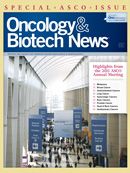Publication
Article
Oncology & Biotech News
Novel Agent Motesanib Does Not Pan Out in Advanced NSCLC
Author(s):
Although once considered a promising drug for lung cancer and other tumor types, motesanib added to carboplatin/paclitaxel chemotherapy did not improve overall survival.

Giorgio Scagliotti, MD
Although once considered a promising drug for lung cancer and other tumor types, motesanib added to carboplatin/paclitaxel (CP) chemotherapy did not improve overall survival (OS) in patients with advanced non—small cell lung cancer (NSCLC) versus chemotherapy with CP alone in the randomized, placebo-controlled, double-blind, phase III MONET1 study, whose results were reported in June at the ASCO meeting.
Motesanib is a multitargeted selective oral inhibitor of VEGFR 1, 2, and 3; PDGRF; and KIT. These targets are thought to mediate cancer-related signaling. Lead author of this poster presentation, Giorgio Scagliotti, MD, of the University of Turin in Italy, said that the modest numeric increases in progression- free survival (PFS) and overall response rate (ORR) favoring motesanib suggest that the drug has some activity in NSCLC. Nevertheless, the study failed to meet its primary endpoint for this novel agent.
Baseline characteristics were well-balanced between the 2 arms. Median age was 60 years; 61% were men; about 72% were current or past cigarette smokers; about two-thirds were white; and about 13% were stage IIIb and 87% were stage IV. About 80% had adenocarcinoma histology and about 20% had squamous histology. Initially, the study included all histologies but was amended to exclude patients with squamous histology due to a high rate of hemoptysis.
Patients (N = 1090) with nonsquamous histology were randomized in a 1:1 ratio to receive up to 6 3-week cycles of CP (carboplatin every 3 weeks at AUC 6 mg/mL/min and paclitaxel 200 mg/m2 every 3 weeks) with either motesanib 125 mg every day (Arm A) or with placebo (Arm B). The primary endpoint was overall survival (OS). At the time of the analysis, 653 patients had died (608 with adenocarcinoma). Median followup was 10.6 months.
The addition of motesanib did not significantly improve OS. Median OS in patients with nonsquamous NSCLC was 13% in Arm A (CP plus motesanib) versus 11% in Arm B (CP alone); in patients with adenocarcinoma, median OS was 13.5 months versus 11 months, respectively. Median PFS in nonsquamous patients was 5.6 months for Arm A versus 5.4 months for Arm B; median PFS was identical in patients with adenocarcinoma. ORR was 40% for Arm A versus 26% for Arm B in nonsquamous patients, and 39% and 25%, respectively, for adenocarcinoma patients; this difference was statistically significant for both types of tumors favoring motesanib (P <.0001).
In 356 patients in Arm A with evaluable placenta growth factor (PIGF) samples at baseline and after 1 treatment, there was no association between the log-transformed fold change from baseline to week 4 and OS. PIGF is being studied as a potential biomarker in NSCLC; overexpression of PIGF is associated with pathological angiogenesis and correlates with tumor size and expression of angiogenic receptors.
Grade 3 and 4 adverse events occurring more frequently in the motesanib-containing arm were neutropenia (22% vs 15%, respectively), diarrhea (9% vs 1%, respectively), hypertension (7% vs 1%, respectively), and cholecystitis (3% vs 1%, respectively). The incidence of grade 5 adverse events was 14% in Arm A and 9% in Arm B.
It is not clear whether Amgen, Millennium, and Takeda, the companies that are jointly developing motesanib, plan to pursue further studies in NSCLC, or if these results will end the development program.
Scagliotti G, Vynnychenko I, Ichinose Y, et al. An international, randomized, placebo-controlled, double-blind phase III study (MONET1) of motesanib plus carboplatin/paclitaxel in patients with advanced nonsquamous non—small cell lung cancer. J Clin Oncol. 2011;29(suppl; abstr LBA7512).









